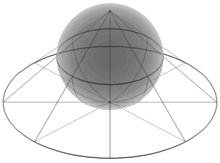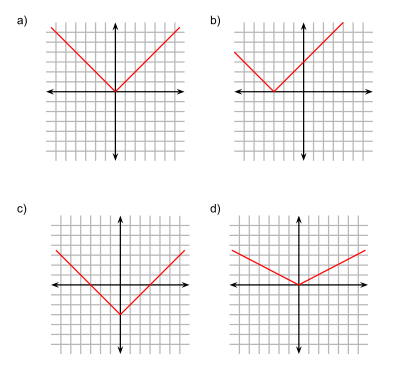解析幾何

| 幾何學 |
|---|
 |
| 幾何學家 |
|
|
解析幾何(英語:Analytic geometry),又稱為坐標幾何(英語:Coordinate geometry)或卡氏幾何(英語:Cartesian geometry),早先被叫作笛卡兒幾何,是一種藉助於解析式進行圖形研究的幾何學分支。解析幾何通常使用二維的平面直角坐標系研究直線、圓、圓錐曲線、擺線、星形線等各種一般平面曲線,使用三維的空間直角坐標系來研究平面、球等各種一般空間曲面,同時研究它們的方程式,並定義一些圖形的概念和參數。
在中學課本中,解析幾何被簡單地解釋為:採用數值的方法來定義幾何形狀,並從中提取數值的資訊。然而,這種數值的輸出可能是一個方程式或者是一種幾何形狀。
1637年,笛卡兒在《方法論》的附錄「幾何」中提出了解析幾何的基本方法。 以哲學觀點寫成的這部法語著作為後來牛頓和萊布尼茨各自提出微積分學提供了基礎。
對代數幾何學者來說,解析幾何也指(實或者複)流形,或者更廣義地通過一些複變數(或實變數)的解析函數為零而定義的解析空間理論。這一理論非常接近代數幾何,特別是通過讓-皮埃爾·塞爾在《代數幾何和解析幾何》領域的工作。這是一個比代數幾何更大的領域,不過也可以使用類似的方法。
歷史
[編輯]古希臘數學家梅內克繆斯(Menaechmus)的解題、證明方式與現在使用坐標系十分相似,以至於有時會認為他是解析幾何的鼻祖。[1] 阿波羅尼奧斯在《論切觸》中解題方式在現在被稱之為單維解析幾何;他使用直線來求得一點與其它點之間的比例。[2]阿波羅尼奧斯在《圓錐曲線論》中進一步發展了這種方式,這種方式與解析幾何十分相似,比起笛卡兒早了1800多年。他使用了參照線、直徑、切線與現今所使用坐標系沒有本質區別,即從切點沿直徑所量的距離為橫坐標,而與切線平行、並與數軸和曲線向交的線段為縱坐標。他進一步發展了橫坐標與縱坐標之間的關係,即兩者等同於誇張的曲線。然而,阿波羅尼奧斯的工作接近於解析幾何,但他沒能完成它,因為他沒有將負數納入系統當中。在此,方程式是由曲線來確定的,而曲線不是由方程式得出的。坐標、變量、方程式不過是一些給定幾何題的腳註罷了。[3]
十一世紀波斯帝國數學家歐瑪爾·海亞姆發現了幾何與代數之間的密切聯繫,在求三次方程式使用了代數和幾何,取得了巨大進步。[4][5]但最關鍵的一步由笛卡兒完成。[4]
從傳統意義上講,解析幾何是由勒內·笛卡兒創立的。[4][6][7]笛卡兒的創舉被記錄在《幾何學》(La Geometrie)當中,在1637年與他的《方法論》一道發表。這些努力是以法語寫成的,其中的哲學思想為創立無窮小演算提供了基礎。最初,這些著作並沒有得到認可,部分原因是由於其中論述的間斷,方程式的複雜所致。直到1649年,著作被翻譯為拉丁語,並被馮·斯霍滕(van Schooten)恭維後,才被大眾所認可接受。[8]
費馬也為解析幾何的發展做出了貢獻。他的《平面與立體軌跡引論》(Ad locos planos et solidos isagoge)雖然沒有在生前發表,但手稿於1637年在巴黎出現,正好早於笛卡兒《方法論》一點。[9]《引論》文字清晰,獲得好評,為解析幾何提供了鋪墊。費馬與笛卡兒方法的不同在於出發點。費馬從代數公式開始,然後描述它的幾何曲線,而笛卡兒從幾何曲線開始,以方程式的完結告終。[8]結果,笛卡兒的方法可以處理更複雜的方程式,並發展到使用高次多項式來解決問題。
基本理論
[編輯]
坐標
[編輯]在解析幾何當中,平面給出了坐標系,即每個點都有對應的一對實數坐標。最常見的是笛卡兒坐標系,其中,每個點都有坐標對應水平位置,和坐標對應垂直位置。這些常寫為有序對。這種系統也可以被用在三維幾何當中,空間中的每個點都以多元組呈現。
坐標系也以其它形式出現。在平面中最常見的另類坐標系是極坐標系,其中每個點都以從原點出發的半徑和角度表示。在三維空間中,最常見的另類坐標系統是圓柱坐標系和 球坐標系。
曲線方程式
[編輯]在解析幾何當中,任何方程式都包含確定面的子集,即方程式的解集。例如,方程式在平面上對應的是所有坐標等於坐標的解集。這些點匯集成為一條直線,被稱為這道方程式的直線。總而言之,線性方程式中和定義線,一元二次方程式定義圓錐曲線,更複雜的方程式則闡述更複雜的形象。
通常,一個簡單的方程式對應平面上的一條曲線。但這不一定如此:方程式對應整個平面,方程式只對應一點。在三維空間中,一個方程式通常對應一個曲面,而曲線常常代表兩個曲面的交集,或一條參數方程式。方程式代表了是半徑為r且圓心在上的所有圓。

距離和角度
[編輯]在解析幾何當中,距離、角度等幾何概念是用公式來表達的。這些定義與背後的歐幾里得幾何所蘊含的主旨相符。例如,使用平面笛卡兒坐標系時,兩點和之間的距離 (又寫作,被定義為
上述可被認為是一種畢氏定理的形式。類似地,直線與水平線所成的角可以定義為
其中是線的斜率。
變化
[編輯]
變化可以使母方程式變為新方程式,但保持原有的特性。例如,母方程式 有水平和垂直的漸近線,處在第一和第三象限當中能夠,它所有的變形都有水平和垂直的漸近線,出現在第一或第三、第二或第四象限當中。總的來說,如果,那麼它可以變為。新的變形方程式, 因素如果大於1,就垂直拉伸方程式;如果小於1,就壓縮方程式。如果 值為負,那麼方程式就反映在 -軸上。 值如果大於1就水平壓縮方程式,小於1就拉伸方程式。與一樣,如果為負就反映在-軸上。 和 值為平移,值是垂直, 為水平。 和 的正值意味著方程式往數軸的正方向移動,負值意味這往數軸的負方向移動。
變化可以應用到任意幾何等式中,不論等式是否代表某一方程式。 變化可以被認為是個體處理、或是組合處理。
例如, 在 平面上指代單位圓。 圖像可以被變化為:
- 將變為 ,使得圖像向右移動個單位。
- 將變為,使得圖像向上移動個單位。
- 將變為,使得圖像以值拉伸。 (想像一下 被膨脹了)
- 將變為,使得圖像垂直拉伸。
- 將變為,將 變為 ,使得圖像旋轉 個角度。
在基礎的解析幾何中,不會考慮太多的變化,例如偏移。更多資訊請參閱仿射轉換。
交集
[編輯]雖然本討論僅限於平面上,但它可以很容易地衍生為更高維的空間中。兩個幾何物件和指代和,其交集是所有點的集合。 例如,可以是半徑為1的圓,圓心在: , 可以是半徑為1的圓,圓心在。兩圓的交叉點是滿足方程式的所有點的集合。點是否滿足方程式呢?將帶入,便成為或,結論為真,因此在上。換句話來說,接著將帶入,方程式 成為 或 ,結論為假。 不在 上,因此不是它的集合。
與 的交集可以通過同時解方程式來求得:
解得
我們的交集有兩點:
就圓錐曲線而言,交集可能會出現至多4個點。
截距
[編輯]被廣泛研究的一種交集是幾何物件與和坐標軸的交集。
幾何物件與 軸的交集被稱之為物件的 截距。與軸的交集被稱之為物件的截距。
就線 而言,參數定義線在何處與軸相交。據此,或點被稱之為截距。
主題
[編輯]解析幾何中的重要問題:
. 如果被考慮進去的話,就會常常用到旋轉。這些問題常涉及到線性代數。
例子
[編輯]下面是美國初中數學競賽(USMTS)中的題,可以用解析幾何來解:
問題:在凸面五邊形中,邊長為 , , , , ,雖然順序不一定如此。設, , , 成為 , , , 的各個中點。 設 為線段 的中點, 為線段 的中點。線段 的長度為整數。求邊 的所有可能長度。
解: 為了不失一般性,假設 , , , , 為 , , , , 。
應用中點公式,點 , , , , , 位於
- , , , , ,
使用距離公式,
以及
由於 為整數,
(見同餘) 因此 .
現代解析幾何
[編輯]解析簇(analytic variety)定義為幾個解析函數的共同解集。類似與實數與複數的代數簇。任何複流形都是一種解析簇。由於解析簇可能有奇異點,但不是所有解析簇都是複數。.
解析幾何母體上來說等同與實數與複數代數幾何,讓-皮埃爾·塞爾在他的著作《代數幾何與解析幾何》(Géometrie Algébrique et Géométrie Analytique)闡述了這個觀點。然而,兩個領域依然有其獨特性,而證明方式也十分不同,代數幾何也包括幾何的有限特徵。
注釋
[編輯]- ^ Boyer, Carl B. The Age of Plato and Aristotle. A History of Mathematics Second Edition. John Wiley & Sons, Inc. 1991: 94–95. ISBN 0-471-54397-7.
Menaechmus apparently derived these properties of the conic sections and others as well. Since this material has a strong resemblance to the use of coordinates, as illustrated above, it has sometimes been maintained that Menaechmus had analytic geometry. Such a judgment is warranted only in part, for certainly Menaechmus was unaware that any equation in two unknown quantities determines a curve. In fact, the general concept of an equation in unknown quantities was alien to Greek thought. It was shortcomings in algebraic notations that, more than anything else, operated against the Greek achievement of a full-fledged coordinate geometry.
- ^ Boyer, Carl B. Apollonius of Perga. A History of Mathematics Second Edition. John Wiley & Sons, Inc. 1991: 142. ISBN 0-471-54397-7.
The Apollonian treatise On Determinate Section dealt with what might be called an analytic geometry of one dimension. It considered the following general problem, using the typical Greek algebraic analysis in geometric form: Given four points A, B, C, D on a straight line, determine a fifth point P on it such that the rectangle on AP and CP is in a given ratio to the rectangle on BP and DP. Here, too, the problem reduces easily to the solution of a quadratic; and, as in other cases, Apollonius treated the question exhaustively, including the limits of possibility and the number of solutions.
- ^ Boyer, Carl B. Apollonius of Perga. A History of Mathematics Second Edition. John Wiley & Sons, Inc. 1991: 156. ISBN 0-471-54397-7.
The method of Apollonius in the Conics in many respects are so similar to the modern approach that his work sometimes is judged to be an analytic geometry anticipating that of Descartes by 1800 years. The application of references lines in general, and of a diameter and a tangent at its extremity in particular, is, of course, not essentially different from the use of a coordinate frame, whether rectangular or, more generally, oblique. Distances measured along the diameter from the point of tangency are the abscissas, and segments parallel to the tangent and intercepted between the axis and the curve are the ordinates. The Apollonian relationship between these abscissas and the corresponding ordinates are nothing more nor less than rhetorical forms of the equations of the curves. However, Greek geometric algebra did not provide for negative magnitudes; moreover, the coordinate system was in every case superimposed a posteriori upon a given curve in order to study its properties. There appear to be no cases in ancient geometry in which a coordinate frame of reference was laid down a priori for purposes of graphical representation of an equation or relationship, whether symbolically or rhetorically expressed. Of Greek geometry we may say that equations are determined by curves, but not that curves are determined by equations. Coordinates, variables, and equations were subsidiary notions derived from a specific geometric situation; [...] That Apollonius, the greatest geometer of antiquity, failed to develop analytic geometry, was probably the result of a poverty of curves rather than of thought. General methods are not necessary when problems concern always one of a limited number of particular cases.
- ^ 4.0 4.1 4.2 Boyer. The Arabic Hegemony. 1991: 241–242.
Omar Khayyam (ca. 1050–1123), the "tent-maker," wrote an Algebra that went beyond that of al-Khwarizmi to include equations of third degree. Like his Arab predecessors, Omar Khayyam provided for quadratic equations both arithmetic and geometric solutions; for general cubic equations, he believed (mistakenly, as the sixteenth century later showed), arithmetic solutions were impossible; hence he gave only geometric solutions. The scheme of using intersecting conics to solve cubics had been used earlier by Menaechmus, Archimedes, and Alhazan, but Omar Khayyam took the praiseworthy step of generalizing the method to cover all third-degree equations (having positive roots). .. For equations of higher degree than three, Omar Khayyam evidently did not envision similar geometric methods, for space does not contain more than three dimensions, ... One of the most fruitful contributions of Arabic eclecticism was the tendency to close the gap between numerical and geometric algebra. The decisive step in this direction came much later with Descartes, but Omar Khayyam was moving in this direction when he wrote, "Whoever thinks algebra is a trick in obtaining unknowns has thought it in vain. No attention should be paid to the fact that algebra and geometry are different in appearance. Algebras are geometric facts which are proved."
缺少或|title=為空 (幫助) - ^ Glen M. Cooper (2003). "Omar Khayyam, the Mathematician", The Journal of the American Oriental Society 123.
- ^ Stillwell, John. Analytic Geometry. Mathematics and its History Second Edition. Springer Science + Business Media Inc. 2004: 105. ISBN 0-387-95336-1.
the two founders of analytic geometry, Fermat and Descartes, were both strongly influenced by these developments.
- ^ Cooke, Roger. The Calculus. The History of Mathematics: A Brief Course. Wiley-Interscience. 1997: 326. ISBN 0-471-18082-3.
The person who is popularly credited with being the discoverer of analytic geometry was the philosopher René Descartes (1596–1650), one of the most influential thinkers of the modern era.
- ^ 8.0 8.1 Katz 1998,pg. 442
- ^ Katz 1998,pg. 436
引述
[編輯]著作
[編輯]- Katz, Victor J., A History of Mathematics: An Introduction (2nd Ed.), Reading: Addison Wesley Longman, 1998, ISBN 0-321-01618-1
- Boyer, Carl B., History of Analytic Geometry, Dover Publications, ISBN 978-0486438320
- Cajori, Florian, A History of Mathematics, AMS, ISBN 978-0821821022
- Struik, D. J., A Source Book in Mathematics, 1200-1800, Harvard University Press, ISBN 978-0674823556
文獻
[編輯]- Boyer, Carl B. Analytic Geometry: The Discovery of Fermat and Descartes, Mathematics Teacher 37, no. 3 (1944): 99-105
- Boyer, Carl B., Johann Hudde and space coordinates
- Bissell, C. C., Cartesian geometry: The Dutch contribution
- Pecl, J., Newton and analytic geometry
- Coolidge, J. L., The Beginnings of Analytic Geometry in Three Dimensions
外部連結
[編輯]- Coordinate Geometry topics (頁面存檔備份,存於網際網路檔案館) with interactive animations






















![{\displaystyle y=af[b(x-k)]+h}](https://wikimedia.org/api/rest_v1/media/math/render/svg/0f34caab00b2cedd33661cbd66c097371f05abbf)





































































